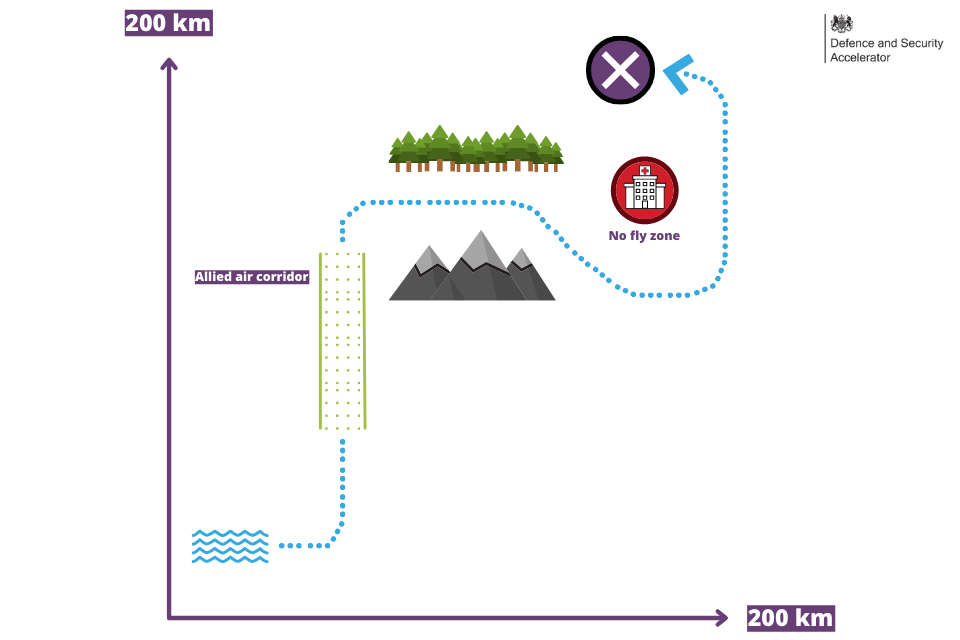Navigation in Weapon Systems
Updated 17 February 2022
Short Induction to Weapon Operation
Weapons provide the vast majority of the Armed Forces lethality. Complex weapons are the general term used to define weapons that are able to carry out demanding tasks in challenging environments. Modern complex weapons are required to be highly precise only engaging the target and nothing else, and do so in a very complicated environment.
Weapon systems often include many elements but the most visible is the effector or missile. A missile flight pattern with relevance to navigation can be characterised below:

Schematic of weapon deployment
Note on size, weight and power (and cost) (SWaP-C)
Weapon systems are designed and built by balancing subsystem performance against each other. The other main considerations of system and sub-system design is SWaP-C. Generally speaking in this respect SWaP-C requirements for navigation systems are broadly the same as current UAV systems of a similar size.

Soldiers firing missile
Weapon Lifecycle
One of the more unusual aspects of weapon systems is the lifecycle. Weapons spend much of their life either in storage, in-transit or mounted (stored in a launcher or ready use magazine). These weapons are not routinely powered up so they could spend many years unpowered before use. When weapons are powered up and used, this will be for a very short timescale (for long range weapons this will be a couple of hours, for close-in weapons might be 30 seconds or less). It is also worth noting that weapons do not return, and are destroyed beyond use when they engage the target.

Engineers inspecting missile
Complex Weapon Types
Below are four general complex weapons types that use (or could potentially use) navigation systems. The type have been selected to be relevant but diverse.
Examples and specification are designed to give an indication of what challenges are, but are generic.
Personnel Portable
These weapons are defined by their ability to be carried and operated by personnel without assistance. These weapons are short range and therefore have short engagement times, but include weapons that engage very different targets. Weapon examples include Javelin and StarStreak.
Example Specification:
- Mass – 10 kg to 25 kg;
- Length – 0.5 m to 1.5 m;
- Diameter – 10 cm to 20 cm;
- Range – up to 3 km;
- Speed – Depends on target – missiles generally need to have a speed advantage of 2 – 3 times the target.
Surface Attack
Surface attack weapons engage most surface targets. These targets might be fixed but are more likely to be semi-fixed (e.g. artillery unit) or mobile (e.g. vehicles). These are similar to long range weapons and can to be sent to an area before terminal guidance takes over. Examples include SPEAR 3 and Brimstone.
Example Specification:
- Mass – 50 kg to 150 kg;
- Length – 1 m to 2 m;
- Diameter – 15 cm to 30 cm;
- Range – 20 km to 150 km;
- Speed – Mach 0.8 (265 ms⁻¹ at sea level) although some weapons might be super-sonic.
Long Range Weapons
Long range weapons engage a multitude of targets at extended range. These are the weapons that generally have the longest deployment time. Examples of these types of weapons include Harpoon Ship to Ship missile and Storm Shadow.
Long range weapons have the most demanding requirement for navigation as they are generally sent to a point in space before terminal guidance methods take over. Several terminal guidance methods include attacking a fixed point. (e.g. military command bunker).
Example Specification:
- Mass – 500 kg to 1000 kg plus;
- Length – 3 m to 5 m;
- Diameter – 30 cm to 50 cm;
- Range – 250 km to 550 km plus;
- Speed – Mach 0.8 (265 ms⁻¹ at sea level).
Air to Air Weapons
These weapons are defined by their ability engage air targets after launching from an aircraft. These targets are some of the fastest targets and are the most manoeuvrable targets.
Air to air weapons navigation requirements are mainly required on beyond visual range weapons but can be very useful on shorter range systems. Weapon examples include Meteor and Advanced Short Range Air to Air Missile (ASRAAM).
Example Specification:
- Mass – up to 250 kg;
- Length – 2 m to 4 m;
- Diameter – 10 cm to 20 cm;
- Range – up to 250 km plus;
- Speed – Generally high supersonic – Mach 4+ (1320 ms⁻¹ at sea level);
- Manoeuvrability – 15 g to 30 g plus.
Please note that these specifications apply to the whole weapon system. Typically a single component such as a navigation system would be up to 10% of the total weight.
